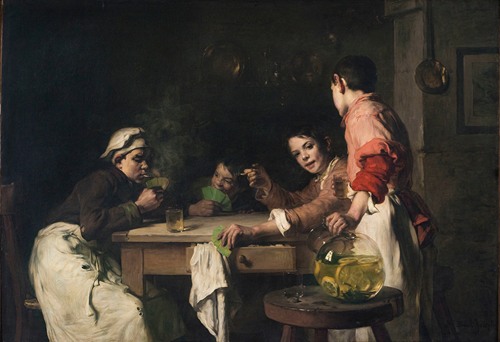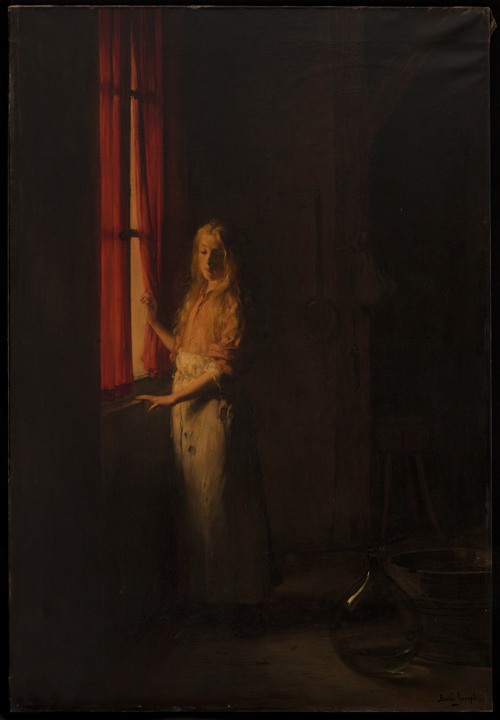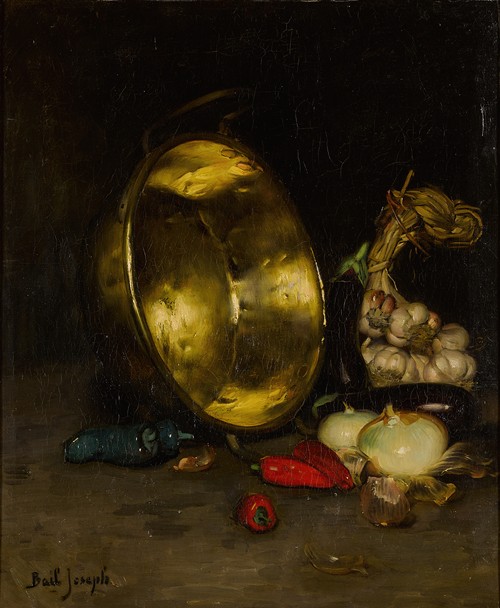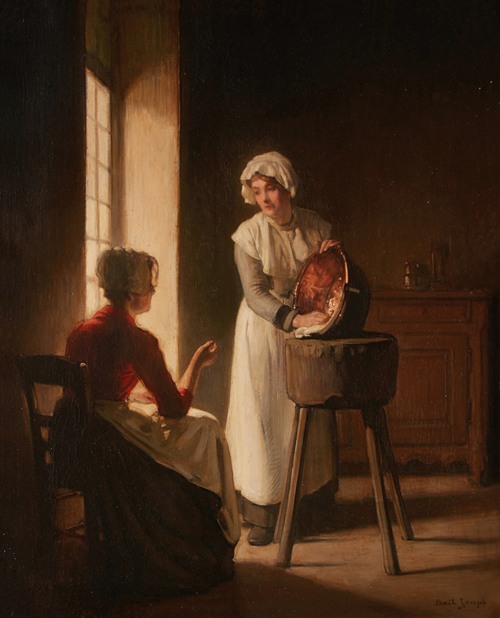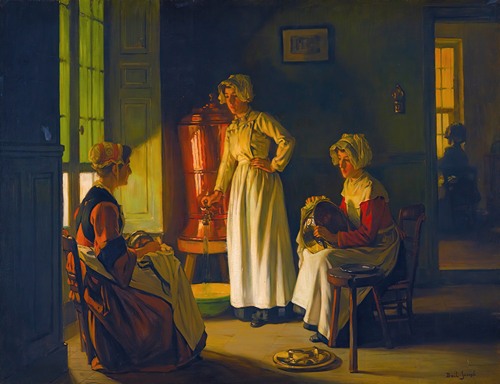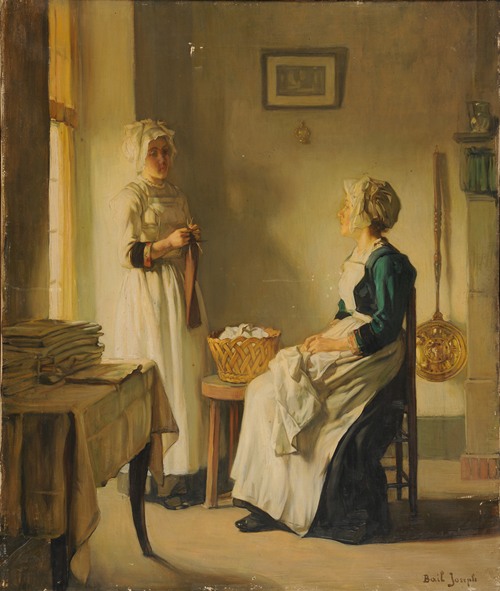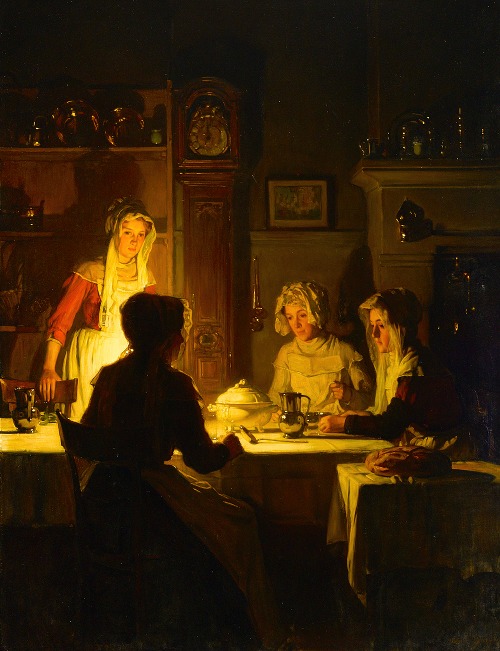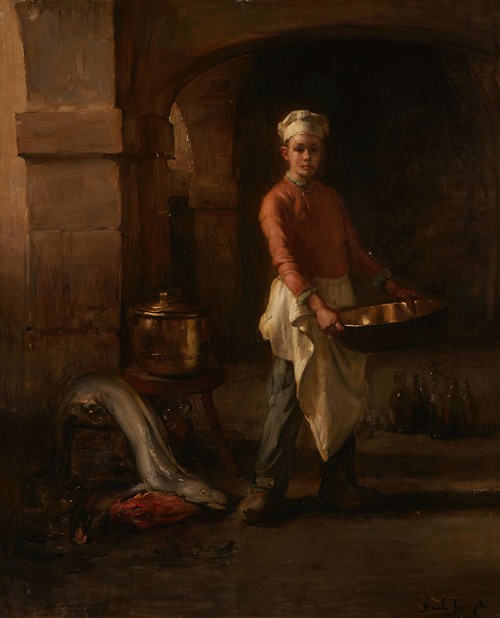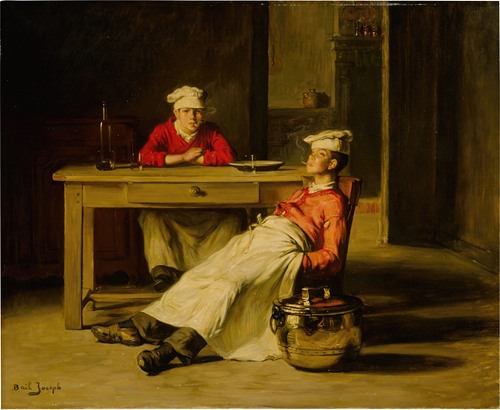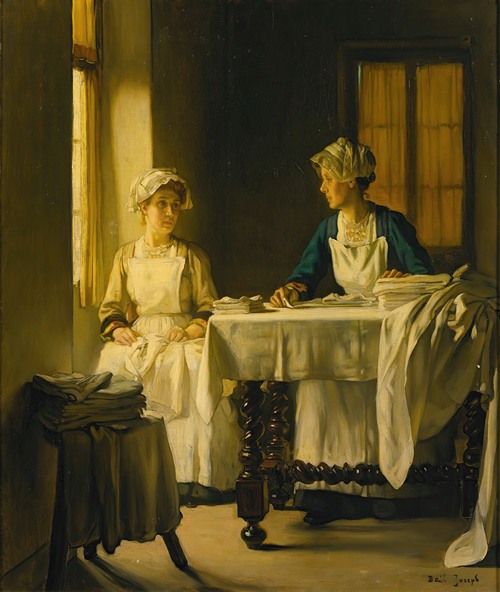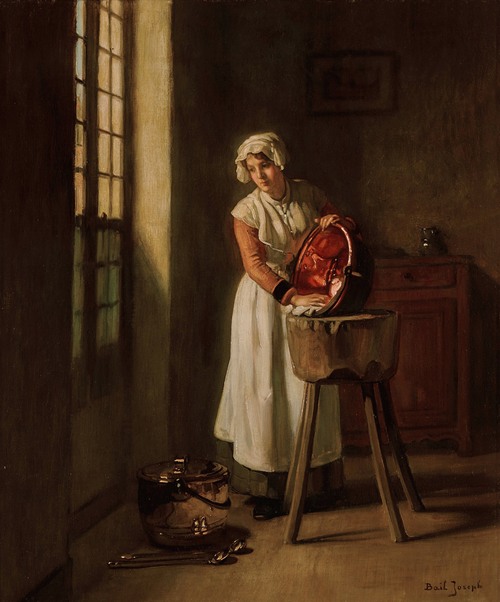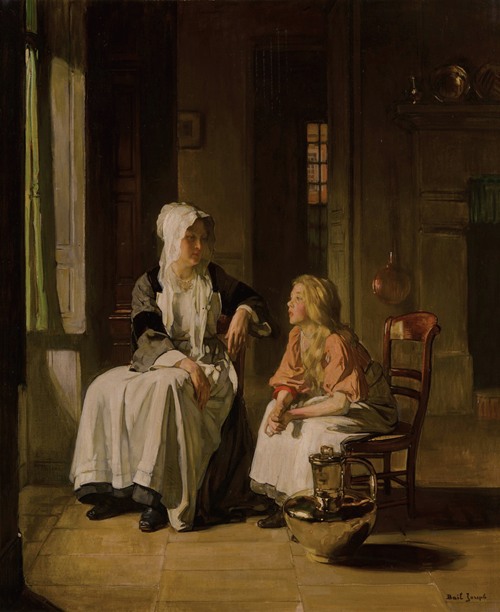
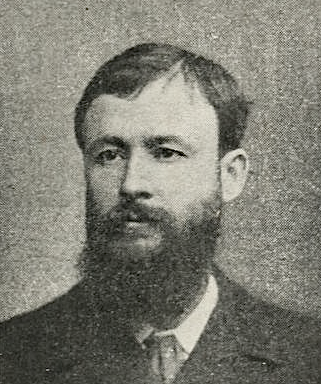
Joseph Bail was born on January 22nd, 1862 in Limonest in the Rhone region of France. His father, Jean-Antoine Bail, was a trained genre painter who was heavily influenced by the Dutch masters and focused his attention on depicting scenes from daily life. It is clear that Joseph, as well as his brother Frank, followed in the footsteps of his father, as he too would be influenced by these artists despite new interests in subjects and representation during this period in France. Gabriel P. Weisberg (in the primary article on the Bail family, “The Bails of Lyon: the Bails and the continuation of a popular Realist Tradition”, Arts Magazine Vol. 55 (8), 1981, pg. 157) wrote that:
While other artists were changing the shape of art through modernist distortions of form, the Bails looked backward, creating a painting style that showed a devotion to the past and reflected the values of former times.
In a period of increasing modernity and industrialization, these paintings glorified the past ways of life in France and found a sympathetic audience in bourgeois patrons.
Presumably beginning at a young age, Joseph’s initial artistic training began with his father who instilled in him a respect for the eighteenth-century French painters such as Jean-Siméon Chardin and the Dutch masters and encouraged him to view their works at the Louvre. (Weisberg, pg. 156) As all three members of the family, Jean-Antoine, Franck, and Joseph, were artists, the Bail family represents one of the few associations of family painters of the Realist tradition remaining during the latter half of the nineteenth century. They could often be found exhibiting alongside one another at the annual Salons, showing work which displayed similar qualities in subject matter. After beginning his training under his father, Bail began studying, presumably between 1879 and 1880, in the atelier of Jean-Léon Gérôme, an accomplished painter and teacher of the period. This was a short-lived period of tutelage as in 1882 he was no longer listed in Salon catalogues as Bail’s teacher, perhaps because Gérôme’s choice of subjects differed quite dramatically from those of his father and those that Bail would follow for the majority of his career.
Just after his sixteenth birthday, Bail debuted at the Salon of 1878, alongside both his father and brother, with Nature Morte (Still Life). The still life tradition in France was invigorated by the work of Jean-Siméon Chardin in the eighteenth century and still lifes continued to be a major interest for many artists and many occupied themselves primarily with this type of painting. They figured as an important element of Bail’s work, and many of his genre scenes also show still life arrangements within the picture, even when they were not the primary focal point. Henry Marcel (La Peinture Française au XIXème Siècle, Paris: A. Picard & Kaan, 1906, pg. 309) remarked that of these that his “Virtuosity rose from the cellars, from the kitchens to the peaceful linen-rooms and the discreet dining-halls, and amuses itself by following from object to object, the caresses of the furtive rays of light.” Bail himself was especially interested in the reflection produced on shiny copper or silver kitchenware, a most poignant suggestion of Chardin’s inspiration in his work.
While still lifes dominate Bail’s beginning work shown at the Salon, he expanded his early themes to also include scenes from the countryside, animals, and genre paintings, some influenced by their summer stays in Bois-le-Roi just outside of Fontainebleau. Just as Claude Monet would do, Bail studied the changing effects of light on haystacks in the countryside. But as his style progressed, he showed a stronger affinity with his father’s work and that of the Chardin and the Dutch masters, choosing to portray room interiors illuminated by a strong light source. In recalling these past masters and this type of painting, Bail was appealing to the growing middle class as his work referenced earlier highly esteemed painters. Emmanuel Bénézit in Dictionnaire Critique et Documentaire des Peintres, Sculpteurs…wrote of Bail and his interiors, that:
He excels at creating in all of his painting a very lively bright light due to the radiant shine of some brilliant point or to the direct projection of the exterior daylight…it’s assuredly the expression of an original and rather harmonious art. His technique is very delicate and his coloring just right. The composition of his painting, always elegant, is skillfully treated.
His interiors often included a figure positioned near a window, illuminated by this strong sense of lighting. It was specifically his interior scenes that caught the attention of contemporary writers, as Bail's entry in the Dictionnaire Nationale des Contemporains (Vol. 5, Paris: Office Édition Générale: 1905, pg. 398), commented on his sensitive approach:
Mr. Joseph Bail painted canvases of the most diverse genres: All of his works are interesting; but those that one finds the most remarkable are his interior scenes, so admirably and so precisely lit, so harmoniously composed, where the shine of the copper and the transparency of the glass add notes of a perfect precision.
He also combined his modeling and placement of objects with his interest in human form and emotion in several of his works, depicting the daily activities of the household as completed by maids and cooks, many of whom were young children, thus continuing the tradition of Théodule Ribot. Bail became best known for these paintings of maids and cooks and with them “Bail continually mirrored the virtues of middle class home life and the traditions of an earlier time,” wrote Gabriel Weisberg (pg. 157). Instead of depicting these figures with solemn expressions that suggested the difficulty of their labor, they often exhibit light-hearted expressions bordering on the humoristic. Weisberg again notes that “Collected by the affluent, Bail’s domestics, like Bastien-Lepage’s urchins, implied a social condition without blatantly revealing the injustices that inflicted the poor. They remain personal and approachable icons to a social order that was to be radically altered by the further mechanization of the twentieth century.” (pg. 159)
Bail regularly submitted to the Salons and towards the end of his careers was “hors concours”, or exempt from having to submit his works for jury approval. He received awards in 1885 (Honorable Mention), 1886 (third-class medal), 1887 (second-class medal), 1889 Exposition Universelle (silver medal), 1900 Exposition Universelle (gold medal), and 1902 (medal of honor). He was also named Chevalier de la Légion d’Honneur in 1900, and was a member of the Société des Artistes Français. He died November 26, 1921.
Joseph Bail presents an oeuvre which was inspired by his father’s interest in earlier masters but also used the current trend in Realism, inspired by his earlier contemporaries such as Théodule Ribot and François Bonvin. His playful images of cooks and their young assistants, along with an interest in light effects, established Bail as an artist who not only looked to the past but who used the modern movement of Realism to execute paintings that showed modern-day preoccupations with daily life that was becoming more and more rare in late nineteenth century France.
